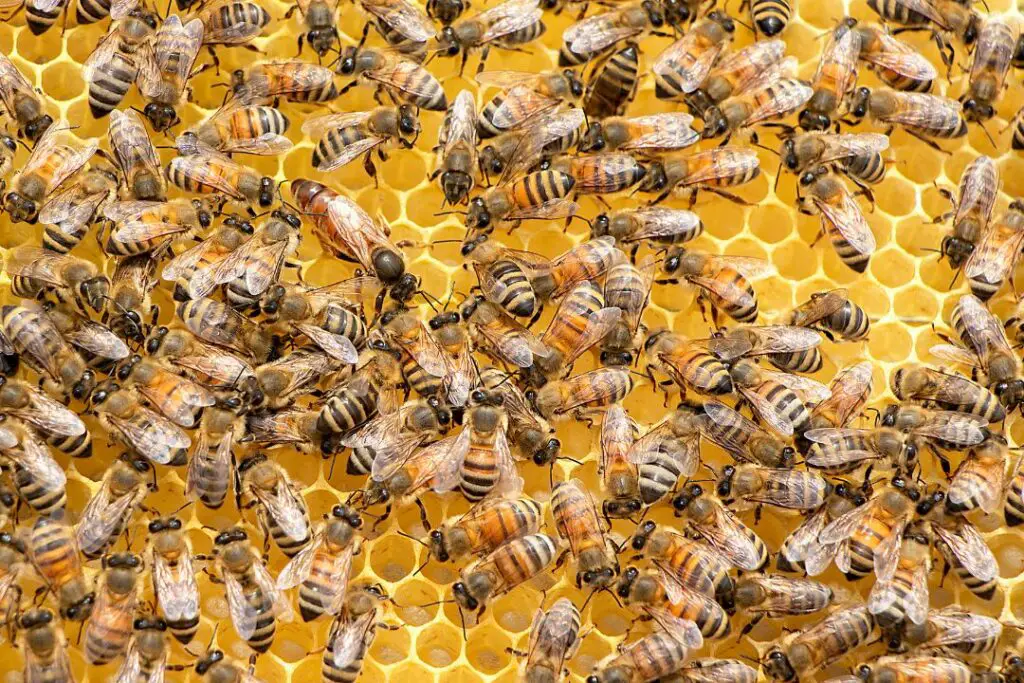Last updated on October 24th, 2023 at 05:28 pm
Bees use a combination of techniques to defend themselves from predators, including:
- Stinging
- Alarm pheromones
- Balling
- Sentry bees
- The soldier caste
- Flight agility
- Swarming
- Shimmering
Now let’s take a closer look at how each is deployed to fend off larger insects and predators.
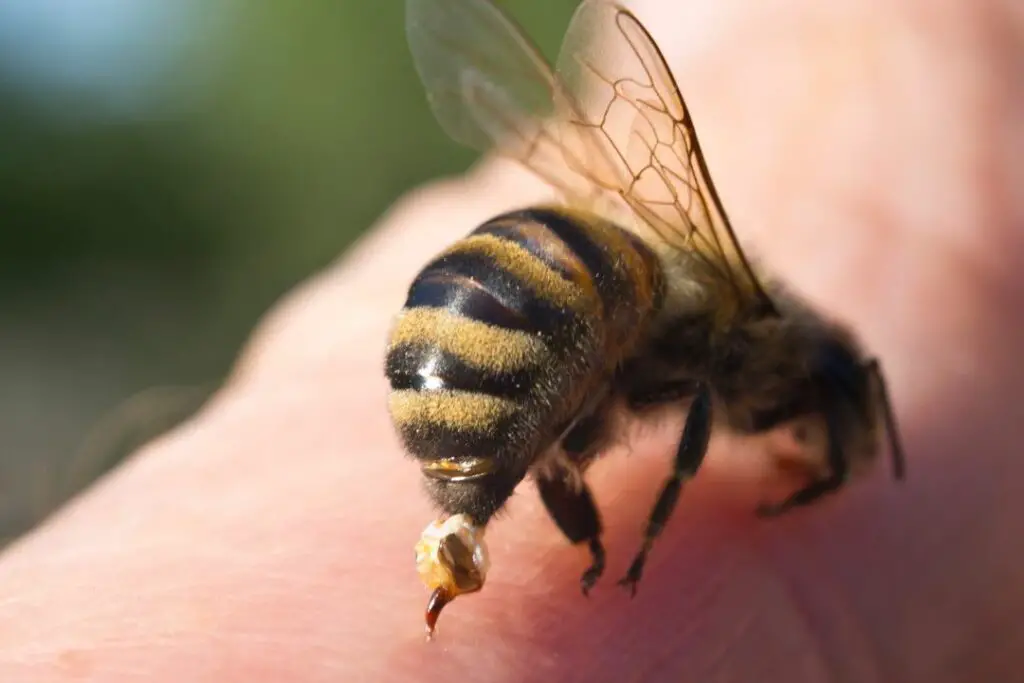
Stinging Defense
Bees are armed with a formidable weapon, their stinging mechanism.
A modified ovipositor female bees use for egg-laying is located at the posterior end of the abdomen.
But this wonder of biology doubles up as a potent deterrent to unwanted visitors.
If and when the bee feels threatened enough, it raises its abdomen and aims its venomous sting at the target.
Each stinger has barbs that act like tiny hooks when plunged into the victim.
This ensures that every drop of the venomous payload is delivered, but it has catastrophic consequences for the bee.
As a bee tries to withdraw the stinger, it can tear away from its abdomen, causing a fatal injury to the bee.
This unique self-sacrificing defence mechanism is found in honeybees, such as the widely known European Honeybee (Apis mellifera) and various bumblebee species (Bombus).
*Got a bee issue? Here are some natural methods for keeping bees away.
Alarm Pheromones
Next, we’re looking at how bees have evolved an ingenious way to communicate and alert their colony to danger.
Pheromones are chemical signals emitted by an individual bee, which affect the behaviour or physiology of other bees within the colony.
When a bee perceives a threat, such as an intruding predator, it releases alarm pheromones.
They act as a warning signal, quickly alerting nearby bees to danger.
Nearby bees receiving this chemical signal modify their behaviour, preparing to respond to the threat.
This plays a crucial role in coordinating the defence efforts of the colony, ensuring a swift and effective response.
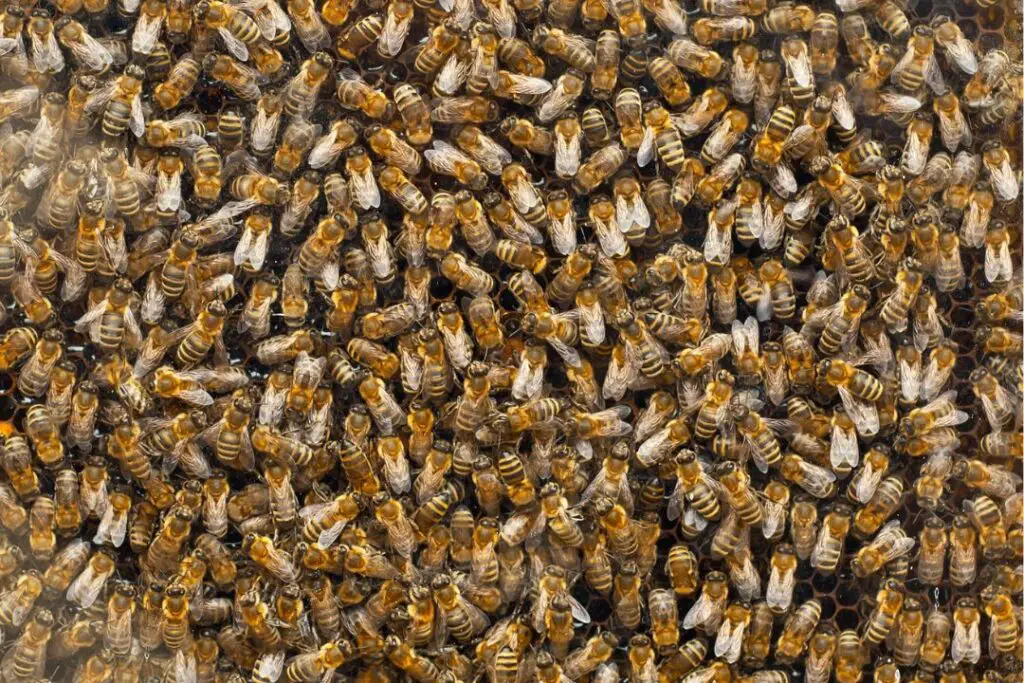
Balling
While the stinging defence is effective against some threats, certain predators, like wasps and hornets, are larger and much more resilient.
When faced with these monstrous insects, bees resort to another defence strategy called “balling.”
Balling is a fascinating behaviour observed in some honey bee species, where the bees form a tight cluster around the intruder to immobilize and neutralize it.
Imagine a group of bees collectively encircling an intruding wasp or hornet.
The bees create a literal ball of bee bodies by enveloping the intruder.
Then they all start to vibrate their flight muscles, generating heat through the rapid movement.
This heat at the centre of the ball begins to rise, and the unfortunate victim will slowly expire.
It’s unclear if the suffocation, stinging or slow cooking finishes the job, but the combination seems to be a highly effective defence strategy.
Here’s a good example of balling at work with some Japanese honey bees fending off their hive against a gigantic Asian hornet.
Sentry Bees
Every successful society needs vigilant sentries, and honeybee colonies are no exception.
Sentry bees are specialized types of bees whose primary responsibility is guarding the nest entrance.
These watchful guardians station themselves at the hive’s entrance, monitoring incoming and outgoing bees and other visitors.
When a potential threat, such as a wasp or a hornet, approaches the hive entrance, the sentry bees spring into action.
They immediately identify the intruder and try to assess its intent.
If they perceive the visitor as a potential attack, they initiate alarm signals by releasing alarm pheromones and performing distinctive movements to alert the rest of the colony.
Sentry bees are essential for early threat detection, allowing the colony to mobilize its defence forces promptly.
Their vigilance and alertness contribute significantly to the hive’s security and survival.
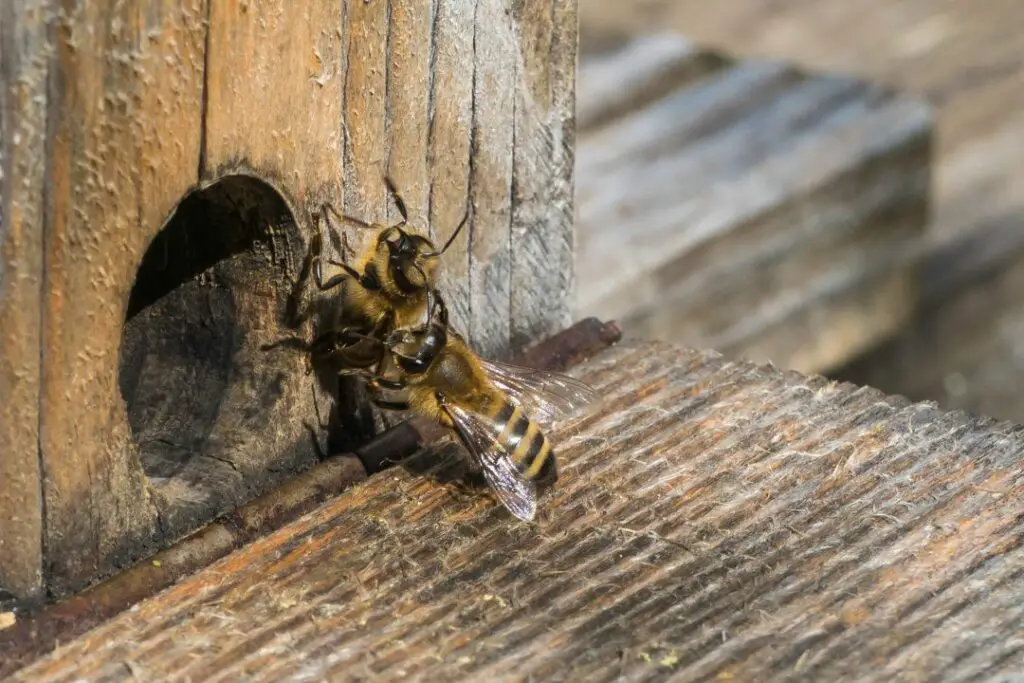
Soldier Caste
A soldier caste is a specialized group of female honeybees in honey bee colonies.
These soldier bees are different from the typical forager or nurse bees and are specifically tasked with defending the colony against threats.
Characteristics of soldier bees
- Morphological Differences: Soldier bees have slightly larger bodies and heads compared to the other worker bees. These physical differences are thought to aid them in their defensive duties.
- Guarding the Hive: The primary role of soldier bees is to act as sentries and guards for the hive entrance. They station themselves near the hive’s entrance and diligently monitor all incoming and outgoing traffic.
- Recognizing Intruders: Soldier bees are skilled at recognizing individuals that do not belong to their colony. They can distinguish between fellow colony members, like foragers returning with nectar or pollen, and intruders, like wasps, hornets, or robber bees.
- Initiating Defense: Soldiers will not hesitate to act when they identify a threat. Soldier bees are more aggressive than worker bees and respond to perceived threats with heightened aggression.
- Alarm Pheromones: Soldier bees release alarm pheromones to alert other colony members about potential dangers. These alarm pheromones spread rapidly within the hive, signalling other bees to prepare for defence.
Development of soldier bees
The development of soldier bees is primarily influenced by the colony’s needs and the availability of resources.
If the colony faces frequent threats or potential attacks, it may produce more soldier bees to bolster defences.
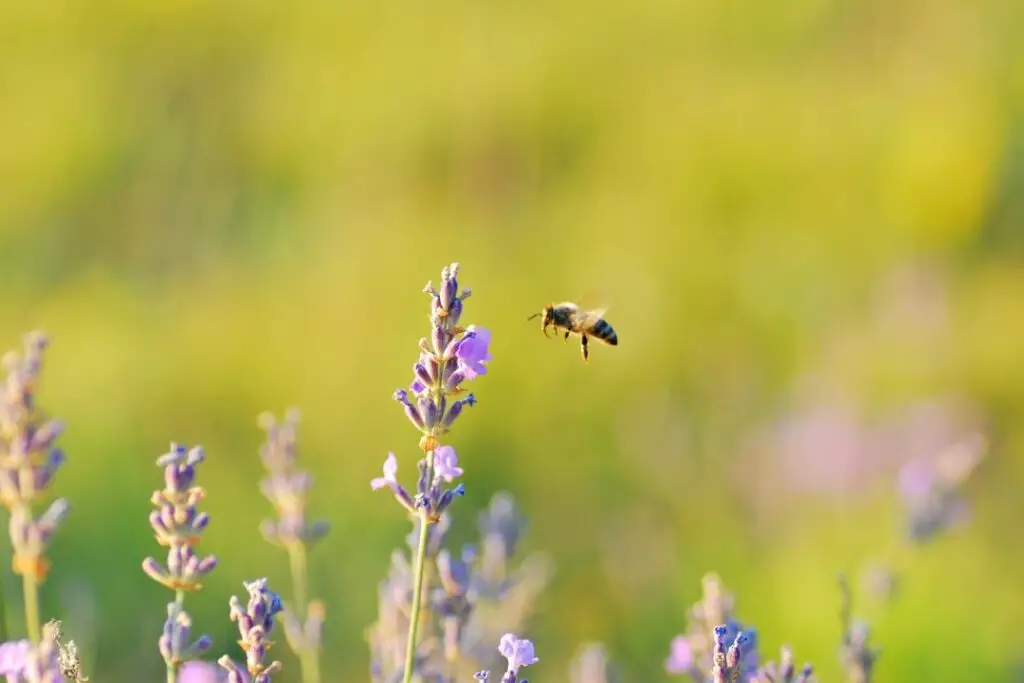
Flight Agility
Bees are not only equipped with physical defences; they are also remarkably agile fliers.
Their wings beat at high speeds (up to a whopping 230 beats per second), allowing them to manoeuvre swiftly through the air with precision.
This flight agility is crucial to their defence, helping them to evade potential predators and other threats.
When a predator attempts to catch a bee in mid-air, the bee may perform rapid twists and turns, making it challenging for the predator to keep up.
This aerial agility is particularly evident in bumblebees, known for their acrobatic flight patterns despite their large size.
Bees can also fly at impressive speeds, making catching them difficult for many predators.
Robbing Screens
Beekeepers play a crucial role in supporting and protecting bee colonies.
One of the tools they use to defend against intruders, like robbing bees and wasps, is the robbing screen.
Robbing screens are simple devices installed at the entrance of the hive.
They create a restricted, narrow entrance, making it easier for the guard bees to defend the hive against unwanted visitors.
The narrow entrance also helps the guard bees control the flow of incoming and outgoing bees more effectively.
During times of scarcity or when weaker colonies struggle to collect nectar and pollen, stronger colonies may attempt to “rob” the weaker ones of their stored resources.
Robbing bees and wasps can significantly threaten the target hive, stealing its precious supplies and potentially harming the colony.
Robbing screens help mitigate these risks by providing the hive with an added layer of protection alongside the sentry bees.
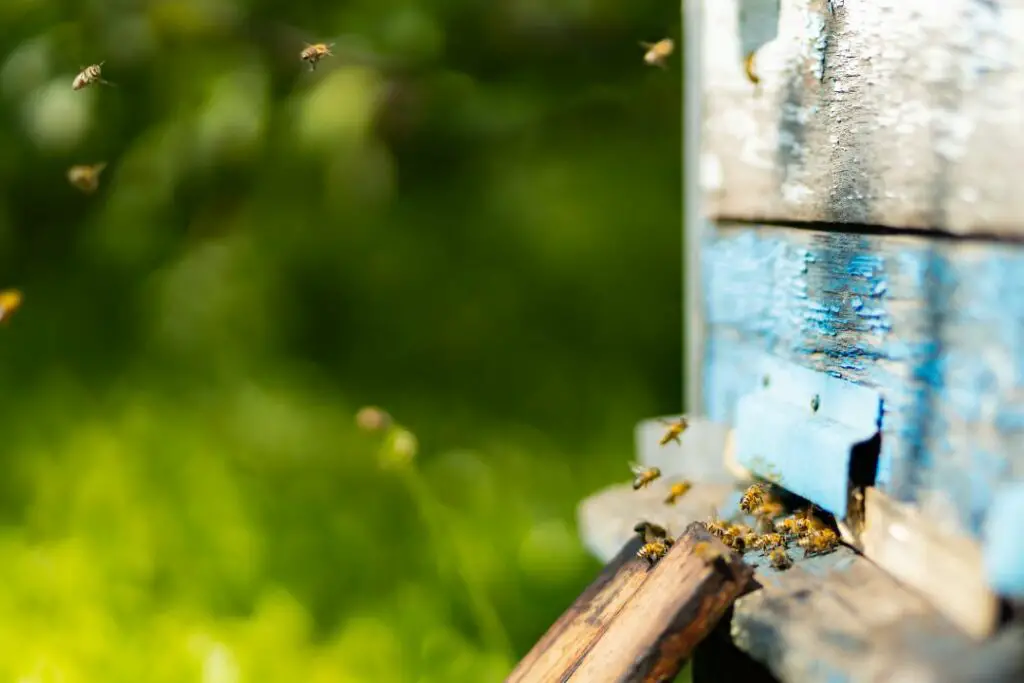
Shimmering
Shimmering, also known as “shivering” or “heating,” is a remarkable defence deployed by the giant honeybees (Apis dorsata) to counter threats and defend their colonies.
They often form open nests, which means they’re vulnerable to observation from hungry guests.
This unique behaviour involves worker bees coordinating their movements to create a visually striking wave-like pattern across the surface of the honeycomb.
How Bees Perform Shimmering
When a honeybee colony perceives an imminent threat, such as an intruding wasp or hornet, certain worker bees on the nest’s outer layers initiate shimmering.
These bees create a wave-like pattern by rapidly moving their bodies back and forth, generating vibrations that travel through the colony.
This creates a visually striking display of rippling motion across the surface of the honeycomb.
Shimmering behaviour is most evident when observed from a distance or in low-light conditions, such as during the evening or early morning when the sunlight casts shadows on the comb creating the effect of a predator flying overhead
The primary purpose of shimmering is to confuse and deter potential predators.
The visual effect created by the synchronized motion of numerous worker bees can be disorienting and intimidating to intruders like wasps or hornets.
The intruder may find it challenging to identify individual bees and perceive the hive as a unified, formidable entity.
In Conclusion
So it turns out bees aren’t as defenceless as we may have thought with various strategies they can call on to defend themselves and fellow colony members.
If you’ve enjoyed learning how bees defend themselves, don’t miss our other fascinating reads packed with bee knowledge.

